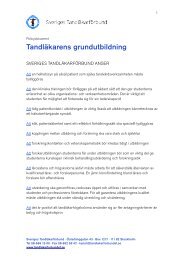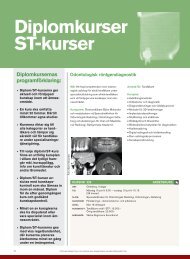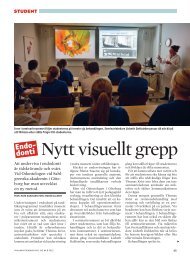Swedish Dental Journal
Swedish Dental Journal
Swedish Dental Journal
Create successful ePaper yourself
Turn your PDF publications into a flip-book with our unique Google optimized e-Paper software.
changes in permeability involve the loss of several<br />
vital processes linked to the cytoplasmic membrane<br />
(17). However, in this study no structural changes<br />
of the cell membrane was seen in any bacteria after<br />
ozone treatment for 60 seconds, irrespective of<br />
species. Even though no holes or destruction of the<br />
cell membrane of the bacteria was seen, not even in<br />
x80,000 magnification (Fig. 7), no bacterial growth<br />
was found in ozone treated samples. This is in contrast<br />
to non-ozone treated samples where an extensive<br />
growth of bacteria was found, which shows that<br />
treated bacteria lacked viability.<br />
One reason for the discrepancy between the findings<br />
of destructed cell membrane after ozone-treatment<br />
in aqueous form as in the study of Nagayoshi<br />
et al. (16) and the present study may be the higher<br />
effectiveness of aqueous ozone compared with gaseous<br />
zone. However, even if the gaseous form is less<br />
effective, no bacterial growth was seen, for the specimens<br />
when treated for 20 seconds or more. No creation<br />
of colonies or bacterial mutuality was found. It<br />
may, therefore, be concluded that gaseous ozone treatment<br />
for more than 20 seconds effectively hinder<br />
bacterial growth on the strips and the agar plates.<br />
No production of external polysaccharides was<br />
found in the treated specimens. This may indicate<br />
that the few bacteria found in the analyzes were inactive.<br />
A recent study (11) has discussed the effectiveness<br />
of ozone in the oral environment, influenced by the<br />
oral bio film. It must be remembered that the ozone<br />
treatment in this study was carried out under laboratory<br />
conditions and the results may therefore not<br />
be directly transferred to the more complex clinical<br />
situation. This study has only shown the effect<br />
of ozone on single strains why conclusions cannot<br />
be drawn concerning dental caries with a more<br />
complex situation with different bacteria present<br />
and different anatomical conditions on the tooth.<br />
Therefore, factors such as penetration depth of the<br />
ozone, different anatomical variations and the influence<br />
of the oral bio film must be subjected to future<br />
research.<br />
Declaration of interests<br />
This study was not conducted on behalf of any commercial<br />
interest. Some of the analyzes in this study<br />
were supported by KaVo <strong>Dental</strong> GmbH, but no honoraria<br />
or employment were funded.<br />
KaVo <strong>Dental</strong> GmbH has not in any way mean<br />
been involved in any part of this study.<br />
fagrell et al<br />
Figure 7.<br />
SEM images of Magnification x80,000 for evaluation of<br />
cellwall deformation.<br />
References<br />
1. Baysan A, Lynch E: Effect of ozone on the oral<br />
microbiota and clinical severity of primary root caries.<br />
Am J Dent 2004;17:56–60<br />
2. Baysan A, Lynch E. The use of ozone in dentistry and<br />
medicine. Prim Dent Care 2005; 12: 47–52.<br />
3. Baysan A, Lynch E. The use of ozone in dentistry and<br />
medicine. Part 2 Ozone and root caries. Prim Dent Care<br />
2006;13:37–41.<br />
4. Baysan A, Whiley RA, Lynch E. Antimicrobial effect of<br />
a novel ozone- generating device on micro-organisms<br />
associated with primary root carious lesions in vitro.<br />
Caries Res 2000;34:498-501.<br />
5. Bocci V. Ozonization of blood for the therapy of viral<br />
diseases and immunodeficiencies. A hypothesis. Med<br />
Hypotheses 1992;39:30-4.<br />
6. Filippi A. Water disinfection of dental units using<br />
ozone – microbiological results after 11 years and<br />
technical problems. Ozone: Science & Engineering<br />
2002;24:479–83.<br />
7. Hicks J, Garcia-Godoy F, Flaitz C. Biological factors in<br />
dental caries: role of remineralization and fluoride in<br />
the dynamic process of demineralization and<br />
remineralization. J Clin Pediatr Dent. 2004;28:203-14.<br />
8. Holmes J. Clinical reversal of root caries using ozone,<br />
double-blind, randomised, controlled 18-month trial.<br />
Gerodontology 2003; 20: 106-14.<br />
9. Kim JG, Yousef AE, Dave S: Application of ozone for<br />
enhancing the microbiological safety and quality of<br />
foods: a review. J Food Prot 1999;62:1071-87.<br />
10. Millar BJ, Hodson N. Assessment of the safety of two<br />
ozone delivery devices. J Dent 2007;35:195-200<br />
11. Müller P, Guggenheim B, Schmidlin PR. Efficacy of<br />
gasiform ozone and photodynamic therapy on a<br />
multispecies oral biofilm in vitro. Eur J Oral Sci<br />
2007;115:77–80.<br />
146 swedish dental journal vol. 32 issue 3 2008
















